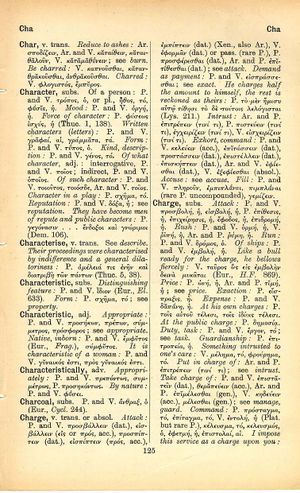character: Difference between revisions
Θεοῦ γὰρ οὐδεὶς χωρὶς (ἐκτὸς οὐδεὶς) εὐτυχεῖ βροτῶν → Nullus beatus absque numine est dei → Glückselig Gott allein und sonst kein Sterblicher
(D_2) |
(Gf-D_2) |
||
| Line 1: | Line 1: | ||
{{Woodhouse1 | {{Woodhouse1 | ||
|Text=[[File:woodhouse_125.jpg|thumb|link= | |Text=[[File:woodhouse_125.jpg|thumb | ||
|link={{filepath:woodhouse_125.jpg}}]]'''subs.''' | |||
<b class="b2">Of a person</b>: P. and V. [[τρόπος]], ὁ, or pl., [[ἦθος]], τό, [[φύσις]], ἡ. | <b class="b2">Of a person</b>: P. and V. [[τρόπος]], ὁ, or pl., [[ἦθος]], τό, [[φύσις]], ἡ. | ||
| Line 28: | Line 29: | ||
}} | }} | ||
{{Gaffiot | {{Gaffiot | ||
|gf=<b>chăractēr</b>, ēris, m. ([[χαρακτήρ]]),<br /><b>1</b> [[fer]] à marquer les bestiaux : Isid. Orig. 20, 16, 7 || marque au [[fer]] : Col. Rust. 11, 2, 14<br /><b>2</b> [fig.] caractère, particularité d’un style : Luciliano charactere libelli [[Varro]] R. 3, 2, 17, satires dans la manière de [[Lucilius]] [en grec d. Cic. Or. 134 ]. | |gf=<b>chăractēr</b>, ēris, m. ([[χαρακτήρ]]),<br /><b>1</b> [[fer]] à marquer les bestiaux : Isid. Orig. 20, 16, 7 || marque au [[fer]] : Col. Rust. 11, 2, 14<br /><b>2</b> [fig.] caractère, particularité d’un style : Luciliano charactere libelli [[Varro]] R. 3, 2, 17, satires dans la manière de [[Lucilius]] [en grec d. Cic. Or. 134 ].||marque au [[fer]] : Col. Rust. 11, 2, 14<br /><b>2</b> [fig.] caractère, particularité d’un style : Luciliano charactere libelli [[Varro]] R. 3, 2, 17, satires dans la manière de [[Lucilius]] [en grec d. Cic. Or. 134 ]. | ||
}} | }} | ||
Revision as of 07:30, 14 August 2017
English > Greek (Woodhouse)
subs.
Of a person: P. and V. τρόπος, ὁ, or pl., ἦθος, τό, φύσις, ἡ.
Mood: P. and V. ὀργή, ἡ.
Force of character: P. φύσεως ἰσχύς, ἡ (Thuc. 1, 138).
Written characters (letters): P. and V. γραφαί αἱ, γράμματα, τά.
Form: P. and V. τύπος, ὁ.
Kind, description: P. and V. γένος, τό.
Of what character, adj.: interrogative, P. and V. ποῖος; indirect, P. and V. ὁποῖος.
Of such character: P. and V. τοιουτος, τοιόσδε, Ar. and V. τοῖος.
Character in a play: P. σχῆμα, τό.
Reputation: P. and V. δόξα, ἡ; see reputation.
They have become men of repute and public characters: P. γεγόνασιν . . . ἔνδοξοι καὶ γνώριμοι (Dem. 106).
Latin > English (Lewis & Short)
chăracter: ēris, m., = χαρακτήρ.
I An instrument for branding or marking, etc.: character est ferrum coloratum, quo notae pecudibus inuruntur, χαρακτήρ autem Graece, Latine forma dicitur, Isid. Orig. 20, 16, 7.—
II Usu., the mark or sign burned or imprinted.
A Prop. (esp. upon animals): quadrupedia charactere signare, Col. 11, 2, 14; Pall. Jan. 16: characterem infigere alicui, Aug. Contr. Cresc. 1, 30.—
B Trop., a characteristic, mark, character, style, etc. (only ante- and postclass.): Luciliano charactere libelli, Varr. R. R. 3, 2, 17; Serv. ad Verg. E. 3, 1; Diom. p. 481 P. (cf. Cic. Or. 39, 134; id. Q. Fr. 2, 15 (16), 5; and Gell. 7, 14, 1, in which passages it is written as Greek).
Latin > French (Gaffiot 2016)
chăractēr, ēris, m. (χαρακτήρ),
1 fer à marquer les bestiaux : Isid. Orig. 20, 16, 7 || marque au fer : Col. Rust. 11, 2, 14
2 [fig.] caractère, particularité d’un style : Luciliano charactere libelli Varro R. 3, 2, 17, satires dans la manière de Lucilius [en grec d. Cic. Or. 134 ].

